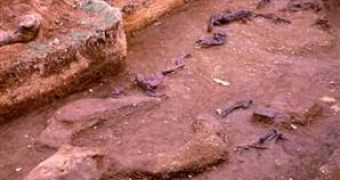It is becoming increasingly clear now that people inhabited Americas earlier than what has been previously believed. A study published in April, based on human coprolites (fossilized feces) found in a cave in Oregon, came up with a date for the remains, of about 14,300 years, which is with more than 1,000 years earlier than Clovis people, believed to have been the oldest people in the Americas. Now, human food remains found in Monte Verde (southern Chile) have been dated to be about the same age, as detailed in the Science journal by a team led by anthropologist Tom Dillehay of the Vanderbilt University.
This is extremely interesting, as we are talking about the extreme south of the Americas. The common theory says that the first Americans followed herds of migrating mammals, crossing Behringia, an ancient land bridge joining Siberia and Alaska, and then migrated southward along the West coast. This is one of the very few fossil proofs to confirm this.
14,000 years ago, during the middle of the last Ice Age, the sea level was about 200 ft (60 m) lower than now, and when the glaciers melted at the end of Ice Age, coastal areas, the places where the first Americans would have dwelt, were flooded.
"There is a continuous mountain chain along the western side of the Americas, with thousands of rivers and streams flowing down the mountains to the ocean. This would have encouraged north-to-south migration, with some groups choosing to turn and follow rivers inland. Places like the Paisley Caves in Oregon and Monte Verde in Chile are ideal locations for such settlements. Genetic and linguistic evidence is beginning to build a fairly strong case that movement was primarily along the coast. I tend to think that, even if they came down the coastline, it was a slow process. We're just not finding all of the archaeological sites, yet," Dillehay said.
Monte Verde is located 500 mi (800 km) south of Santiago (the capital of Chile) and 10 mi (16 km) inland. The site seems to have been inhabited by 20 to 30 people; in the ancient hearths, the researchers discovered remains coming from 9 species of seaweed and marine algae, vegetables, nuts, shellfish, an extinct llama species and a gomphothere (a type of primitive elephant). The researchers also found samples of chewed seaweed, including two species that still have local medicinal use. Other seaweed had been burned, thus cooked.
"Beach stones and other materials were also found at the inland site, indicating the people at Monte Verde had a stronger coastal tradition than was previously known. Monte Verde was originally studied several decades ago, but the seaweed remains were only just discovered in a new analysis of recovered materials. The materials in Oregon and Chile were radiocarbon-dated at 14,200 and 14,500 calendar years ago," Dillehay concluded by saying.

 14 DAY TRIAL //
14 DAY TRIAL //